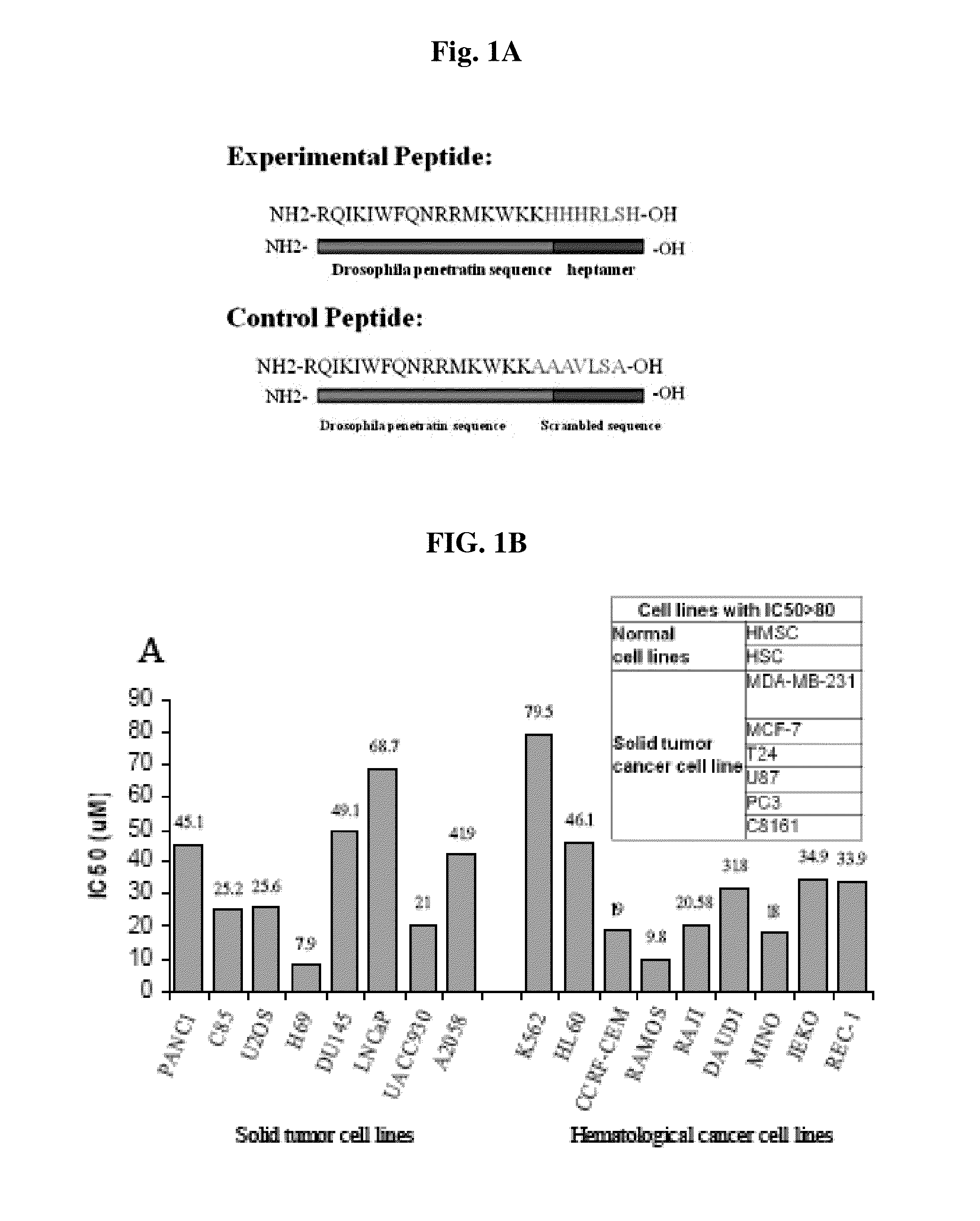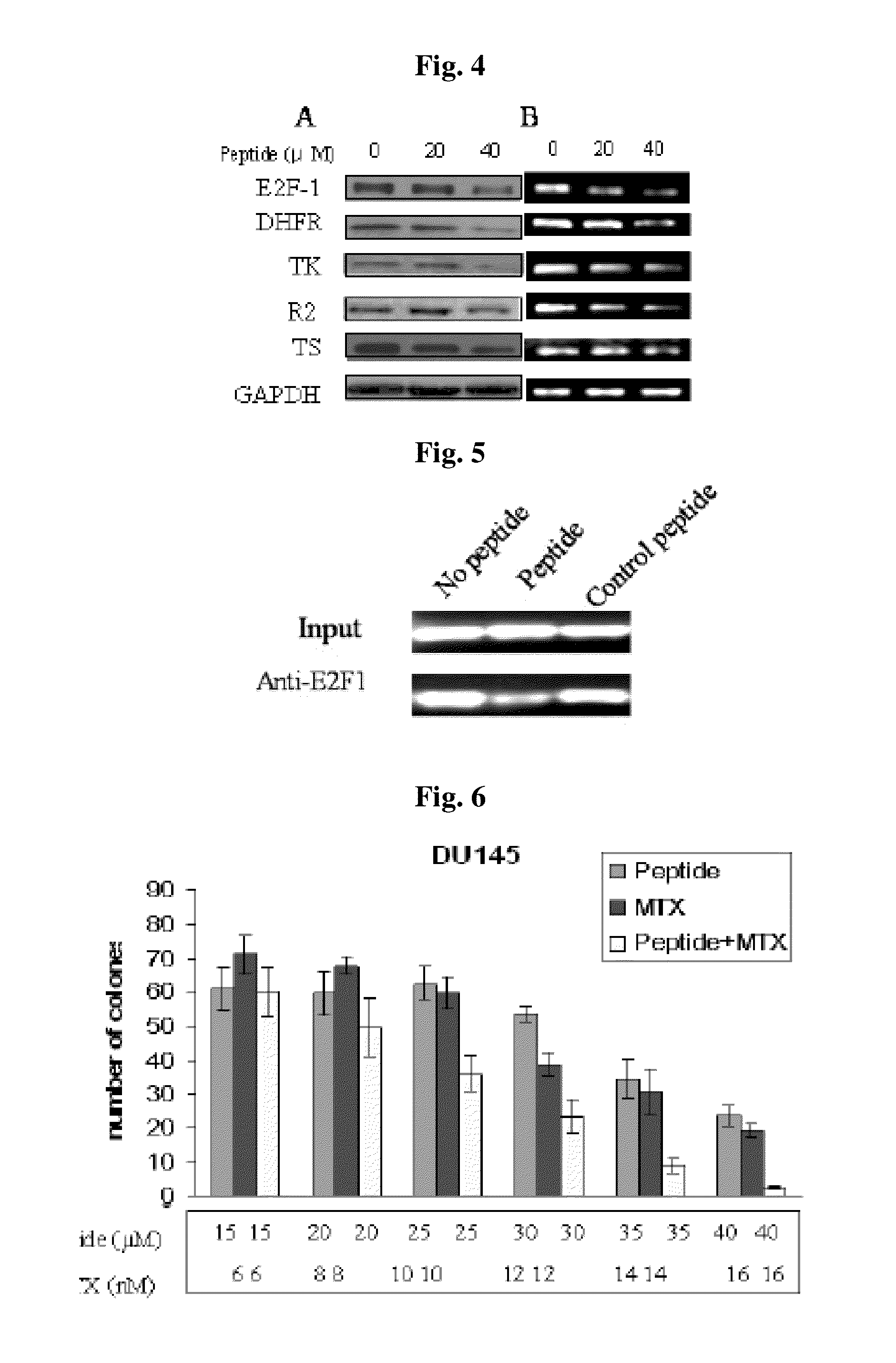E2F as a target of hormone refractory prostate cancer
a prostate cancer and e2f technology, applied in the field of inhibitors of e2f activity, can solve the problems of cell death, inability to completely satisfy the strategy, and inability to inhibit e2f1 expression
- Summary
- Abstract
- Description
- Claims
- Application Information
AI Technical Summary
Benefits of technology
Problems solved by technology
Method used
Image
Examples
example 1
Generation of an E2F-1 Inhibitory Peptide
[0065]The inventors have utilized a phage display library to screen a relatively small random peptide combinatorial library (heptamer library) to identify peptides that may bind to DNA at consensus E2F binding sites and thereby interfere with the binding of native E2F protein. Phage display was used to find heptapeptides that bound tightly to an immobilized consensus E2F sequence, shown below (in bold).
[0066]
(SEQ ID NO: 5)5′ATT TAA GTT TCG CGC CCT TTC TCA A-3′(SEQ ID NO: 6)3′TAA ATT CAA AGC GCG GGA AAG AGT-T-5′
[0067]The phage display library contained random peptides fused to the N terminus of the minor coat protein (pIII) of M13 separated by a Gly-Gly-Gly-Ser (SEQ ID NO: 22) spacer. The bait was a 3′ biotinylated 17 bp double stranded oligomer which contained the inverted repeat of the consensus E2F binding site from the human DHFR promoter. Streptavidin coated polystyrene petri dishes (60×15 mm) were used for trapping the biotinylated 17 bp...
example 2
The Peptide Coupled to Penetratin (PEP-1) Inhibits Growth of Many but Not all Human Cancer Cell Lines
[0069]The cells cultured in RPMI media and 10% fetal calf serum were treated with various concentrations of SEQ ID NO: 3 or SEQ ID NO: 19 at various concentrations for 24 hours and cell viability was determined using Vi-CELL automated cell counter.
[0070]The free peptide did not inhibit growth of several tumor cell lines tested, and likely was not taken up by the cells. However, when coupled to penetratin (SEQ ID NO: 2). As shown in FIG. 1A, the peptide was found to be cytotoxic to most, but not all, tumor cell lines, with variable effectiveness (FIG. 1B). A control peptide, with all 4 of the histidines replaced by alanines (see FIG. 1A), had little or no effect on cell growth at comparable PEP concentrations (data not shown). Importantly, normal human CD34 positive cells containing hematopoeitic progenitors (HSC) were relatively insensitive to the PEP (IC50>80 μM), as were marrow mes...
example 3
Cell Death During PEP-1 Exposure
[0073]To determine the mechanism of cell death by PEP-1, DU 145 cells cultured as described above were incubated with the PEP (50 micromolar) for 4 and 24 hours and analyzed for Annexin V and PI staining by flow cytometry (n=3). Annexin V stained cells represents early apoptotic cells, and PI+Annexin V double staining and PI alone staining indicate late apoptosis and necrotic cells.
[0074]Cells underwent apoptosis following as little as a 4 hour exposure (FIG. 3). Similar results were obtained in Ramos cell line (not shown).
PUM
| Property | Measurement | Unit |
|---|---|---|
| time | aaaaa | aaaaa |
| time | aaaaa | aaaaa |
| time | aaaaa | aaaaa |
Abstract
Description
Claims
Application Information
 Login to View More
Login to View More - R&D
- Intellectual Property
- Life Sciences
- Materials
- Tech Scout
- Unparalleled Data Quality
- Higher Quality Content
- 60% Fewer Hallucinations
Browse by: Latest US Patents, China's latest patents, Technical Efficacy Thesaurus, Application Domain, Technology Topic, Popular Technical Reports.
© 2025 PatSnap. All rights reserved.Legal|Privacy policy|Modern Slavery Act Transparency Statement|Sitemap|About US| Contact US: help@patsnap.com



